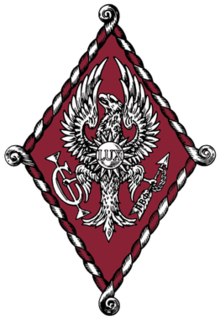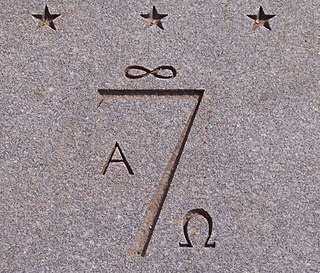Related Research Articles

A secret society is a club or an organization whose activities, events, inner functioning, or membership are concealed. The society may or may not attempt to conceal its existence. The term usually excludes covert groups, such as intelligence agencies or guerrilla warfare insurgencies, that hide their activities and memberships but maintain a public presence.

The Phi Beta Kappa Society (ΦΒΚ) is the oldest academic honor society in the United States, and the most prestigious, due in part to its long history and academic selectivity. Phi Beta Kappa aims to promote and advocate excellence in the liberal arts and sciences, and to induct the most outstanding students of arts and sciences at only select American colleges and universities. It was founded at the College of William and Mary on December 5, 1776, as the first collegiate Greek-letter fraternity and was among the earliest collegiate fraternal societies. Since its inception, 17 U.S. Presidents, 40 U.S. Supreme Court Justices, and 136 Nobel Laureates have been inducted members.

Skull and Bones, also known as The Order, Order 322 or The Brotherhood of Death, is an undergraduate senior secret student society at Yale University in New Haven, Connecticut. The oldest senior class society at the university, Skull and Bones has become a cultural institution known for its powerful alumni and various conspiracy theories. It is one of the "Big Three" societies at Yale, the other two being Scroll and Key and Wolf's Head.

The College of William & Mary is a public research university in Williamsburg, Virginia. Founded in 1693 by letters patent issued by King William III and Queen Mary II, it is the second-oldest institution of higher education in the United States and the ninth-oldest in the English-speaking world. Institutional rankings have placed it among the best public universities in the United States.

Radford University is a public university in Radford, Virginia. It is one of the state's eight doctorate-granting public universities. Founded in 1910, Radford offers curricula for undergraduates in more than 100 fields, graduate programs including the M.F.A., M.B.A., M.A., M.S., Ed.S., Psy.D., M.S.W., and specialized doctoral programs in health-related professions. It is classified among "Doctoral/Professional Universities".

Pi Beta Phi (ΠΒΦ), often known simply as Pi Phi, is an international women's fraternity founded at Monmouth College, in Monmouth, Illinois on April 28, 1867 as I. C. Sorosis, the first national secret college society of women to be modeled after the men's Greek-letter fraternity.
The Bishop James Madison Society is a secret society of the College of William and Mary in Virginia. Students founded the society in the year 1812 as a tribute to the life of the late Bishop James Madison, eighth president of William and Mary and cousin to the U.S. president James Madison. Like other secret societies at the college, the Bishop James Madison Society fell victim to the hostilities of the American Civil War when William and Mary was occupied by Union troops and was forced to close its doors.

The Seven Society is the most secretive of the University of Virginia's secret societies. Members are only revealed after their death, when a wreath of black magnolias in the shape of a "7" is placed at the gravesite, the bell tower of the University Chapel chimes at seven-second intervals on the seventh dissonant chord when it is seven past the hour, and a notice is published in the university's Alumni News, and often in the Cavalier Daily. The most visible tradition of the society is the painting of the logo of the society, the number 7 surrounded by the signs for alpha (A), omega (Ω), and infinity (∞), and sometimes several stars, upon many buildings around the grounds of the university.
The Flat Hat Club is the popular name of a collegiate secret society and honor fraternity founded in 1750 at the College of William and Mary in Williamsburg, Virginia. The fraternity, formally named the "F.H.C. Society", was founded at the College on November 11, 1750. The society maintains relationships with societies at the University of St. Andrews and Amherst College.

Kappa Kappa Gamma (ΚΚΓ), also known simply as Kappa or KKG, is a collegiate sorority founded at Monmouth College in Monmouth, Illinois, United States.

Omicron Delta Kappa (ΟΔΚ), also known as The Circle and ODK, is one of the most prestigious honor societies in the United States with chapters at more than 300 college campuses. It was founded December 3, 1914, at Washington and Lee University in Lexington, Virginia, by 15 student and faculty leaders. The society recognizes achievement in five areas: scholarship; athletics; campus and community service, social or religious activities, and campus government; journalism, speech and the mass media; and creative and performing arts. Some circles of ΟΔΚ are quasi-secret, in that newly selected members remain undisclosed for some time.
There are many collegiate secret societies in North America. They vary greatly in their level of secrecy and the degree of independence from their universities. A collegiate secret society makes significant effort to keep affairs, membership rolls, signs of recognition, initiation, or other aspects secret from the public.
Independence Community College is a public community college in Independence, Kansas, United States. It was formerly known as Independence Community Junior College.

The Red Dragon Society is a secret society based at New York University, in New York, New York. The Red Dragon has long held the title to the most selective society at NYU, and has been known for its secrecy since its founding in 1898.
The North American fraternity and sorority system began with students who wanted to meet secretly, usually for discussions and debates not thought appropriate by the faculty of their schools. Today they are used as social, professional, and honorary groups that promote varied combinations of community service, leadership, and academic achievement.
The Seven Society, Order of the Crown & Dagger is the longest continually active secret society of the College of William & Mary in Williamsburg, Virginia. The clandestine, yet altruistic group is said to consist of seven senior individuals, selected in their junior year. While, historically, graduating members formally announced their identities each spring, today's membership is steeped in mystery and is only revealed upon a member's death.

The history of the College of William & Mary can be traced back to a 1693 royal charter establishing "a perpetual College of Divinity, Philosophy, Languages, and the good arts and sciences" in the British Colony of Virginia. It fulfilled an early colonial vision dating back to 1618 to construct a university level program modeled after Cambridge and Oxford at Henricus. A plaque on the Wren Building, the college's first structure, ascribes the institution's origin to "the college proposed at Henrico." It was named for the reigning joint monarchs of Great Britain, King William III and Queen Mary II. The selection of the new college's location on high ground at the center ridge of the Virginia Peninsula at the tiny community of Middle Plantation is credited to its first President, Reverend Dr. James Blair, who was also the Commissary of the Bishop of London in Virginia. A few years later, the favorable location and resources of the new school helped Dr. Blair and a committee of 5 students influence the House of Burgesses and Governor Francis Nicholson to move the capital there from Jamestown. The following year, 1699, the town was renamed Williamsburg.
Secret societies at the College of William & Mary in Williamsburg, Virginia, date back to the founding of the nation's first known collegiate secret society, The F. H. C. Society. Today a number of secret societies are known to exist at the College: the F.H.C Society or Flat Hat Club, P.D.A., the Seven Society, the 13 Club, the Ladies of Alpha, the Bishop James Madison Society, the Phi Society, the Wren Society, the Sage Society, the W Society, the Y's, The Penny Brigade, The Cord, The Order of the Silver Roses, Dirty Shirley Fraternity, Eagle J, The Fourth Wall, and one group "simply called the Society."

Cornell literary societies were a group of 19th-century student organizations at Cornell University in Ithaca, New York, formed for the purpose of promoting language skills and oratory. The U.S. Bureau of Education described three of them as a "purely literary society" following the "traditions of the old literary societies of Eastern universities." At their peak, the literary societies met in a room called "Society Hall," located within North University.
Fraternities and sororities, also referred to as Greek-letter organizations (GLOs) or, collectively, as "Greek life" in North America and the Philippines, are social organizations at colleges and universities. A form of the social fraternity, they are prominent in Canada, the United States, Europe and the Philippines. Similar organizations exist in other countries, including the Studentenverbindungen of former and current German-speaking countries and the goliardie in Italy.
References
- ↑ "Shhhhh....It's A Secret | William & Mary". www.wm.edu. Retrieved 2018-12-06.
- ↑ "Shhh! The Secret Side to the College's Lesser Known Societies - The DoG Street Journal". 2011-09-28. Archived from the original on 2011-09-28. Retrieved 2018-12-06.